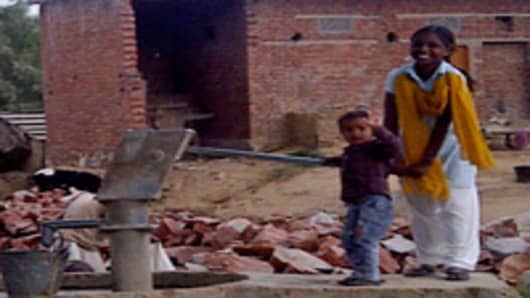The world has achieved its first Millennium Development Goal of cutting extreme poverty in half ahead of the 2015 deadline, a study by the World Bank shows.
The bank defines extreme poverty as living on under $1.25 per day, adjusted for purchasing power parity. According to the report, released this week, 1.29 billion people, or 22 percent of the developing world’s population, live below $1.25 a day, down from 52 percent in 1981.
“The developing world has made considerable progress in fighting extreme poverty,” said Martin Ravallion, the director of the bank’s research group, although that doesn’t mean they have comfortable lives. “The 663 million people who moved above the poverty lines typical of the poorest countries are still poor by the standards of middle- and high-income countries.”
In India, 32.7 percent of the population subsists on less than $1.25 per day and 69 percent make only $2 a day. In rural India, 34.28 percent of the population lives on less than $1.25 a day, down from 43.83 percent in 2005. In urban India, 28.93 percent of the population is in extreme poverty, down from 36.16 percent in 2005, according to the report.
The rapid pace of India’s economic growth has only widened the income gap in the country, which the World Bank measures using the “Gini coefficient.” In India the Gini coefficient has increased from 31 in 1994 to 33 in 2005.
World Bank analysts said South Asia is making progress. “The pace of improvement between 2005 and 2010 for those living below the $1.25 poverty line has been faster than previously observed,” said Rinku Murgai, a lead poverty specialist at the World Bank for South Asia. But the number of people living below $2 a day continues to be very high, she said, “and a large number of people remain vulnerable to moving back into poverty.”
With only seven percent of its population classified as extremely poor, Sri Lanka is the top performer in South Asia; Bhutan follows closely at its heels with 10.2%. Bangladesh is the worst performer -43 percent of its citizens subsist on less than $1.25 a day. India is the second-worst in South Asia.
South Asia as a whole saw its $1.25 a day poverty rate fall from 61 percent to 36 percent between 1981 and 2008, but the region’s poverty statistics are better only than sub-Saharan Africa, where 47 percent of the population lives in extreme poverty.
Brazil has a slightly higher poverty line of $2.50 a day, below which 15 percent of its population falls. However, the inequality in asset distribution is steep. The poorest two-fifths of the Brazilian population together earn less than 10 percent of the national income, whereas in India the two poorest quintiles earn 21 percent of the national income.


